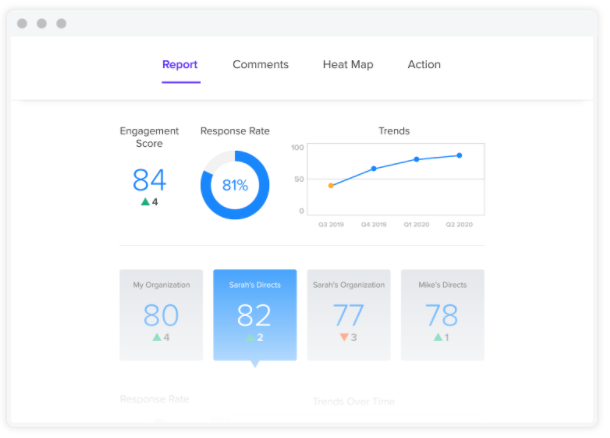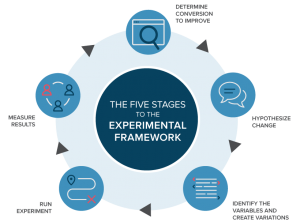Responding directly to your employees’ feedback is a key driver of engagement. In fact, 90 percent of workers say they are more likely to stay at an employer that takes and acts on feedback. That second part is critical, as soliciting feedback but failing to act on it is extremely disempowering. Follow-through is of utmost importance and needs to be timely. Don’t waste months arduously identifying a list of a dozen areas for improvement and fleshing out a strategy for addressing them. If you wait too long and employees aren’t aware of your process, they will assume nothing is being done about their employee engagement survey results. Instead, develop micro-actions that will result in incremental change, so employees can see results faster.
Below, we outline best practices and top tips on how to quickly and properly respond to employee engagement survey results.
Best practices to follow
It’s important to keep a few best practices in mind when sifting through employee engagement survey results. To avoid any personal biases when reviewing the data, and to incentivize honest feedback from employees, all data should be anonymized before it is subjected to analysis.
When analyzing your data, ask important questions. Are any results particularly surprising? Which require immediate action, and which are less pressing? These are the type of questions that will help guide you on how to properly respond to employee engagement survey results. Start with reading comments and using analytics dashboards to get a quick overview on survey results, and then dive deeper into each data set for additional insights.
You should generally prioritize issues by their potential impact on your team and organization. For example, if the data shows that employees aren’t feeling appreciated, you should encourage employees to participate in your recognition program and build promotional campaigns to nip this trend in the bud. Or if you find that employees aren’t buying into your culture or company values, it’s time to take action before your business faces the consequences of a poor work environment. After the most pressing issues are resolved, you can move on to other areas of improvement. Whatever the issue is, loop in relevant stakeholders early on.
Analyze employee engagement survey results
Interpreting the results of employee engagement surveys is the first step towards making them count, and managers need to take the lead. Managers are in the best position to take action on feedback, so having them review survey results relevant for their team — and giving them the tools they need to do so — is critical. HR should play an important supporting role, guiding and empowering managers on how to leverage the survey tools and resources provided.
Here are some ways you can use your voice of the employee platform to analyze data on employee engagement.
Comments
Employees’ comments represent key qualitative information that can give you important insights into the “why” behind their responses. Sorting through dozens of comments can be difficult, however, so look for a platform that gives you the option of sorting them by category, like “Enthusiasm,” “Recognition,” or “Areas of Improvement.” Comments are extremely valuable and it’s this type of qualitative data that will help you assess engagement levels and gather any potential recommendations.
Engagement scores
An engagement score is a single metric that gives you an at-a-glance indication of how engaged your employees are. You should be able to easily access this metric per question, for your direct reports, or for the organization as a whole. And finding a platform that lets you display trends in engagement scores over time is an excellent way to see how your engagement initiatives are progressing.
Response rate
The response rate to the survey as a whole and to certain questions is a great indicator for how comfortable and willing your employees are to provide honest feedback. A low response rate may mean your employees are disengaged or that your organization lacks the environment of psychological safety necessary to provide meaningful feedback. You should aim for a response rate of between 80 to 90 percent if your organization has less than 50 employees, 70 to 80 percent if your organization has a few hundred, and 65 to 80 percent if you employ 1,000 or more people.
Heat maps
A heat map is a grid showing metrics across question categories so you can easily identify the problem areas in your organization or team. They provide visual cues to highlight information, like where a score sits in comparison to relevant benchmarks. Visually identifying hotspots is a great place to start, and you’ll get further insights on which issues you should prioritize when you discuss the results with your team. Try identifying the top two areas for improvement and areas of strength for your team.

An example of Achievers Listen’s Heat Map Report
Spread of responses
When you’re digging into responses to specific questions, you need an easy way to see the spread of negative to positive answers. A visualization that color-codes responses for easy reference and understanding is a must. If the responses to certain questions are especially polarized — featuring a high number of extremely negative and extremely positive responses — that may indicate a lack of alignment within your workforce that needs to be addressed.
Benchmarks
Try benchmarking yourself against other departments or teams, or track your team’s progress against the organization as a whole. If your team is falling behind, look for successful initiatives other departments have implemented that you might be able to adapt for your own purposes. Or if your team is excelling in particular areas, consider providing insights on how you’ve succeeded so other teams can follow in your footsteps.
Dashboards
Managers will greatly benefit from an intuitive dashboard that provides them with data on key metrics in a single place and lets them easily navigate to more analytics tools and detailed reports. Dashboards let anyone efficiently review survey data and gather key insights, and they can be customized to suit individual managers’ needs as well.

Achievers Listen’s dashboard
Additional drivers of engagement
Your surveys should also focus on other important drivers of engagement. These include satisfaction, alignment, future orientation, well-being, support, and recognition. If you see poor engagement scores and negative comments for questions related to long-term fit at your company, for instance, it’s time to take a serious look at professional development initiatives and establishing clear career paths.
Build a collaborative action plan
Just 1 in 5 HR and engagement leaders agreed that their employees deeply trust their company leaders, and only 22 percent say their organization is effective at fostering a culture that supports clear feedback. Many managers forget that each person has unique engagement needs and should be consulted when developing strategies for tackling complex issues in the workplace.
The ultimate goal of your action plan should be to empower employees to take ownership in responding to feedback and their own engagement. Managers that fail to involve their employees and fellow leaders when establishing an action plan experience lower engagement rates overall. Provide a safe space where employees feel comfortable contributing to the conversation. Inspire managers to get to know their employees on a personal level and motivate them to recognize those who are speaking up. By encouraging employee participation when developing a collaborative action plan, managers create a culture of feedback based on trust.
Managers should set aside time to speak with their team members to get their input on overall results and their thoughts on how to address them. The best way to do this is for each team manager to host a listening session with their team. At this session, they should walk through the results, highlighting any key pain points and successes, before engaging all team members in a discussion on how to best take action on the results. Ultimately, managers need to create an environment in which employees feel empowered to be a part of the solution and hold their managers accountable.
This means that simply choosing a response from an action library doesn’t cut it. Not only does this make it easy for managers to simply check a box and move it, it doesn’t take into account the unique circumstances of your organization and team to tailor a customized action plan. Instead, managers should go through an action building process that starts with identifying the hotspots to focus on, proceed to planning and engaging in a team listening session, and end with carrying out the follow-up items collaboratively generated during that session. HR can help coach managers through this process of effectively listening to and acting on employee feedback — and using a voice of the employee solution that supports this collaborative action building approach will be key to success.
Remember that identifying ways to quickly respond to feedback — or “micro-actions” — is critical here. Change happens incrementally, so don’t try to build Rome in a day. Instead, work with your team to find at least a few tangible actions you can take that address the problem areas you’ve identified, and immediately begin to implement them. Employees will appreciate seeing their feedback taken seriously and will do everything they can to help make change happen.
Communicate employee engagement survey results
The way you communicate employee engagement survey results depends on your audience. For a company-wide survey, you should share relevant information with all employees before proceeding with individual team meetings. The CEO could hold a company-wide meeting to cover the top areas of focus and discuss how the company will act on the survey results, and then executives and managers can meet with their teams separately to take a deeper dive and create collaborative action plans. By revealing results to everyone, you can emphasize broader opportunities to make the company an even better place to work
For a smaller-scale survey, it’s a good idea to share results with only those employees and teams who participated. In either case, don’t wait too long before sharing results with the team, as every day you wait is another day the feedback becomes less relevant. And to maintain the anonymity of respondents, always reference averaged results.
Note that many people are visual learners, so sharing the outcomes of the survey is best done with a presentation. Your deck should include charts and graphs — especially comparison charts that reveal changes from previous surveys — but it should also be punctuated by respondents’ quotes to demonstrate that HR and management take feedback seriously and actually reads employees’ comments.
Don’t feel the need to touch on every comment or piece of data in the survey though. Be strategic in identifying a limited number of relevant hotspots with the goal of developing action plans around them with your team.
Whatever you do, do not try to spin the data. It will be obvious to your employees, and it devalues their feedback and weakens trust. During the presentation, welcome more commentary, as giving employees a voice can give you more context for complex problems.
Take the pulse of engagement frequently
PSA: Annual employee engagement surveys aren’t enough. Most people cite “survey fatigue” as a reason for limiting their surveys to once a year, but employees are actually exhausted from giving feedback and seeing little to no action in response. By the time leadership visibly takes action on an annual survey, it’s almost time for the next annual survey, and the previous year’s feedback is likely irrelevant.
The good news is that organizations are starting to pay attention. According to Gartner, 89 percent of organizations utilized annual surveys earlier in the decade, but just 30 percent were using other employee monitoring events. These numbers drastically changed over the next several years. Now, only 63 percent of organizations published an annual survey, and 80 percent of companies used other employee monitoring data.
This means that more businesses and employees are reaping the benefits of a culture of continuous listening — and that your organization needs to get on board if you don’t want to fall behind. For example, you can regularly take the pulse of employee engagement to determine how well managers are meeting their needs, and communicate results in a manner that urges prompt action.
One great example of a company that is successfully leveraging employee engagement surveys and listening to their workforce is Bayhealth Medical Center, a not-for-profit healthcare system with more than 4,000 employees. In a recent webinar, Lauren Brittingham, Director of Organizational Health at BayHealth, shared that her organization complements their engagement survey with a channel for continuous listening, as they recognized that engagement is fluid and continual check-ins are required to catch important, quick changes. Bayhealth kept their annual engagement survey to take advantage of years of data while supplementing it with quarterly pulse surveys and weekly check-ins.
By leveraging pulse surveys, Bayhealth was able to regularly identify both how employees felt about their work and the “why” behind their feelings. And check-ins let employees provide real-time feedback on day-to-day issues that required immediate attention — a critical concern in a patient-caring workforce.
Respond to survey results in real-time with the right tools
The importance of responding to employee engagement survey results cannot be understated. Salesforce research found that among workers who felt their voice was heard, 73 percent say that they were empowered to perform their best work. But only 34 percent of organizations believe that their employees actively provide feedback to the organization and leaders, likely because they’re not giving their employees the feedback tools they want. There’s a massive gap between the listening opportunities HR and engagement leaders believe employees crave — always-on feedback tools and quarterly to weekly requests for feedback — and what those employees get — annual surveys or nothing at all.
Do you have any thoughts on this article? Share your comments below.
Business & Finance Articles on Business 2 Community
(103)






